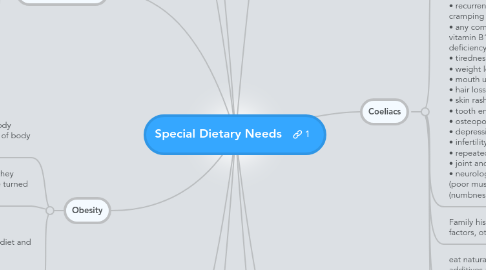Special Dietary Needs
por Alice Chiu


1. Marasmus
1.1. Marasmus is a severe form of malnutrition that consists of the chronic wasting away of fat, muscle, and other tissues in the body
1.2. symptoms will vary depending on the severity and whether associated infections or other conditions are present. General symptoms of marasmus include chronic diarrhea, dizziness, fatigue, and rapid weight loss. If the disease is caused solely by poor nutrition
1.3. Malnutrition occurs when your body does not get enough protein and calories. This lack of nutrition can range from a shortage of certain vitamins to complete starvation.
1.4. a change in diet should be enough to correct the problem and prevent recurrence
2. Anaemia
2.1. Anaemia is a condition where the amount of haemoglobin in the blood is below the normal level, or there are fewer red blood cells than normal.
2.2. tiredness and lethargy (lack of energy), shortness of breath (dyspnoea), changes in your appearance, such as a pale complexion and dry nails
2.3. isn't enough iron in the body
2.4. meat, dried fruit and some vegetables
2.5. taking iron supplements to boost the low levels of iron in the body
3. Lactose intolerance
3.1. Lactose intolerance means the body cannot easily digest lactose, a type of natural sugar found in milk and dairy products
3.2. gas, belly pain, and bloating, cannot digest any milk products
3.3. e small intestine does not make enough of an enzyme called lactase
3.4. Avoid milk products
3.5. lactose intolerance is relatively easy to treat. No known way exists to increase the amount of lactase enzyme the body can make, but symptoms can be controlled through diet
4. Obesity
4.1. Obesity is a term used to describe somebody who is very overweight with a high degree of body fat.
4.2. the person eats more calories than they burn off and the unused calories are turned into fat
4.3. to prevent further weight gain to gradually lose weight through a combination of a calorie-controlled diet and regular exercise to avoid regaining any lost weight to improve your general state of health and reduce your risk of obesity-related complications
5. Malnutrition
5.1. Malnutrition is a serious condition that occurs when a person’s diet does not contain enough nutrients to meet the demands of their body.
5.2. lack of strength or energy to undertake routine activities, or poor physical performance lack of energy and breathlessness (due to anaemia) changes to skin and nails low mood an increase in illnesses or infections
5.3. diet does not contain the right balance of nutrients.
5.4. a feeding tube can be used to provide nutrients directly into the digestive system a drip can be used to provide nutrients and fluids directly into one of the blood vessels Keeping a record of what you eat over a few days and comparing it to the Eatwell plate
6. Type 2 Diabetes
6.1. Diabetes is a lifelong condition that causes a person's blood sugar level to become too high.
6.2. feeling very thirsty urinating frequently, particularly at night feeling very tired weight loss and loss of muscle bulk
6.3. not enough insulin is produced to maintain a normal blood glucose level (insulin deficiency), or your body is unable to use the insulin that is produced effectively (insulin resistance).
6.4. Diabetes cannot be cured, but treatment aims to keep your blood glucose levels as normal as possible to control your symptoms and minimise health problems developing later.
7. Nut Allergy
7.1. An allergy occurs when your body's immune system, which normally fights infection, overreacts to a substance called an allergen
7.2. - Symptoms: • Your mouth and lips tingling. • Your face swelling. • Feeling sick. • Urticaria (nettle rash or hives). • Colicky pains in your abdomen (tummy or stomach). • A feeling of tightness around your throat. • Wheezing or difficulty breathing due to an asthma-like attack, or swelling around your throat. • A sense of impending doom. • Dilation (opening up) of your blood vessels, which can cause: o general redness of your skin o a fast heart rate o a low blood pressure, which can cause you to feel faint or to collapse
7.3. when you first come into contact with nuts your immune system reacts and prepares to fight
7.4. Avoid nuts
7.5. 1. Make sure that you, and others around you like your friends and family, know that you are allergic to nuts and what to do if an allergic reaction starts 2. If an allergic reaction starts, get the right treatment quickly: - Mild reactions can be treated with an antihistamine medicine. - Adrenaline injection: work by injecting adrenaline into your thigh muscle when you press a button or jab it against your skin.
8. Coeliacs
8.1. An autoimmune disease, where the body's immune system attacks its own tissues. In people with coeliac disease this immune reaction is triggered by gluten, a collective name for a type of protein found in the cereals wheat, rye and barley. A few people are also sensitive to oats.
8.2. • diarrhoea, excessive wind, and/or constipation • persistent or unexplained gastrointestinal symptoms, such as nausea and vomiting • recurrent stomach pain, cramping or bloating • any combination of iron, vitamin B12 or folic acid deficiency • tiredness and/or headaches • weight loss (but not in all cases) • mouth ulcers • hair loss (alopecia) • skin rash (dermatitis herpetiformis (DH)) • tooth enamel problems • osteoporosis • depression • infertility • repeated miscarriages • joint and/or bone pain • neurological (nerve) problems such as ataxia (poor muscle co-ordination) and neuropathy (numbness and tingling in the hands and feet).
8.3. Family history, environmental factors, other health conditions
8.4. eat natural foods, free of chemicals, preservatives, additives and other artificial ingredients, as some of these ingredients are sources of hidden gluten and are unhealthy for us all
8.5. gluten diets, Vaccinations, Supplements, Dermatitis herpetiformis
8.5.1. Family history, environmental factors, other health conditions
